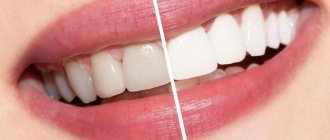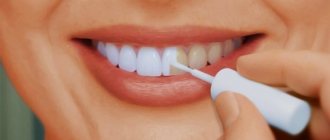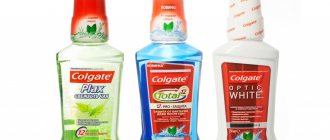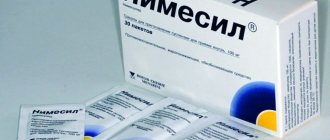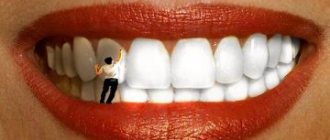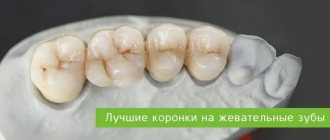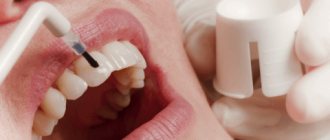There are people who have been brushing their teeth responsibly for years, but cannot achieve a radiant, white-toothed smile. What is the reason? Total injustice, damn it: yellowish or grayish enamel can be inherited from parents or formed during life due to dietary habits. It’s too late to look for reasons and get upset: “Why?!”
Our teeth are covered with enamel, which is the densest tissue in the body - provided that the body is healthy. If you have good genetics, a healthy diet with plenty of nutrients and no problems with internal organs, the enamel should be strong and shiny white. If at least some internal factor has failed, the enamel has every chance of being yellowish, weak, and covered with cracks. Weakness of enamel is a direct path to caries, and in addition to this, such teeth look unaesthetic.
Interesting! Veneers were invented at the request of Hollywood. Initially, veneers were made of plastic and glued to the actors’ teeth right before filming. After work, the actor took off his artificial “teeth,” which would have looked unnatural in real life. Now in Hollywood it is difficult to meet an actor who does not have permanent veneers.
In this article we will not talk about defeating caries (we rely on your awareness and timely treatment of all “wormholes”), but we will talk about how to transform unsightly enamel into a Hollywood smile.
Why do teeth darken?
The most common cause of darkening of teeth is thinning of the enamel. This occurs due to loss of minerals. Often, tooth enamel darkens and turns yellow with age; this is observed even with the most careful oral care. In these cases, dentists recommend using teeth whitening paints.
There are other reasons for darkening of the enamel:
- caries;
- pulpitis;
- poor-quality installation of fillings;
- taking tetracycline-based medications;
- deficiency or excess of fluoride.
If measures to strengthen teeth are not taken in a timely manner, then over time cracks may appear in the enamel, and then caries.
Indications and contraindications for the use of varnish, enamel and other products
Staining is a safe procedure for teeth that does not require grinding, but even such a simple action cannot be performed without consulting a dentist. Your doctor will help you choose a lightening composition so as not to harm your teeth.
| Indications for the use of bleaching agents | Contraindications to the use of teeth whitening |
| The presence of carious cavities in the teeth of the upper and lower rows | Childhood and adolescence up to eighteen years of age |
| Prevention of caries in children and adults | Acute allergic reaction to the components of the composition |
| Hypersensitivity of enamel and microcracks on its surface | Pregnancy and breastfeeding of a small child |
| Very thin enamel | Trauma and mechanical damage to teeth |
| Discoloration of the surface of teeth due to smoking and exposure to chemical compounds or drugs | Severe bleeding gums |
| Changing the color of fillings that do not match the enamel color | Massive chipped part of a tooth |
| Pulp pathologies | Extensive carious cavities with secondary infection |
Indications for use
Dental varnishes and paints are recommended for use in the following cases:
- If the patient has a dark spot on the tooth. This is the initial sign of developing caries.
- If there is increased sensitivity of the teeth to cold or heat, as well as cracking of the enamel.
- With darkening of the enamel of various etiologies.
- If the patient has chipped or wedge-shaped defects in the teeth.
Paints are also used for cosmetic purposes. Such coatings can be used to paint over crowns and fillings.
Thinning and darkening of enamel
A dazzling smile is the dream of every person, so daily oral care is a procedure familiar from childhood.
But often, despite all preventive measures, the loss of minerals that make up the crystal lattice of the enamel occurs, and its thinning begins.
If the mineral layer is not restored in time, the teeth will become more sensitive to temperature changes, microcracks will appear, and then caries.
Darkening is also associated with thinning enamel, but there are many other reasons:
- caries;
- taking tetracycline-based antibiotics;
- lack or excess of fluoride in the body;
- violation of technology when installing seals;
- diseases of the dental pulp.
What does the paint contain?
Let's take a closer look at the composition of dental paints. These preparations can be divided into varnishes and enamels.
Teeth coloring varnishes contain the following components:
- shellac;
- fluoride compounds;
- fir extract;
- chloroform;
- alcohol.
Some varnishes contain calcium compounds. Such products are usually applied over fluoride paints.
The varnish hardens on the surface of the teeth in the form of a film. It prevents plaque formation and bacterial growth. As a result, cracks in the enamel gradually heal.
Tooth enamels consist of the following components:
- substances for the formation of a protective film;
- whitening paste based on titanium dioxide;
- mineral substance (hydroxyapatite).
Enamel lightens teeth by about 10-12 shades. Such products are used for aesthetic purposes and to prevent caries. Enamel helps smooth out tooth irregularities and chips. However, the effect does not last long.
The following is a brief overview of the most popular dental stains.
How is the color of veneers determined?
To select the color of ceramic microprostheses, dentists use a special scale called Vita. It includes:
- 16 natural shades;
- 4 ultra-whites that practically do not exist in nature - Bleach.
Thus, you can choose the appropriate color from as many as 20 options. If the patient only needs a few restorations, the shade of the veneers should match the color of the adjacent teeth. However, if microprostheses are placed over the entire smile area, then the patient is free to choose any color he likes, based on his ideas about beauty and the doctor’s recommendations.
Naturally colored veneers according to the Vita scale are presented in the form of four blocks in accordance with the enamel undertone:
- A - red-brown;
- B - yellow-red;
- C - gray;
- D - gray-red.
There is no need to be alarmed: such a classification does not mean that the selected sample will be red or gray. Only a specialist will see the difference between the tone of ceramic veneers; for patients, they look approximately the same - like ordinary natural teeth.
Each of the four blocks contains four shades, grouped by brightness: from the lightest to the darkest. They are designated by the numbers 1, 2, 3 and 4. Accordingly, all tooth colors on the Vita scale have their own alphabetic and digital number - for example, a2 or b1.
Dental Paint
This product gives your teeth a bright white color. It lightens the enamel by 12-15 tones. Dental Paint is used for severe darkening. It is quite resistant to food and drinks.
This dental paint is made up of beneficial minerals. It is easy to use. 2 minutes after application, a film forms on the surface of the tooth. The paint is applied daily and can be easily removed with a toothbrush or toothpick.
The price of this dental paint in a pharmacy is about 2,000 rubles. The disadvantages of the drug include the short duration of the effect. This remedy improves the appearance of teeth, but has little therapeutic effect. In addition, after applying varnish, teeth look unnaturally white.
Colors of Emax ceramic veneers
Emax glass-ceramic microprostheses differ from conventional ceramic veneers in their manufacturing technology. Accordingly, for overlays of this type there is a separate color scale - Vita 3D-Master. Here, not two, but three color selection options are used.
- Brightness - from 1 to 5.
- The tonality is L (more yellow) and R (more red).
- Saturation - from M1 to M3.
To determine the shade of the future veneer, the doctor first determines its brightness, moving from the darkest to the lightest, then selects the intensity level M and, lastly, the tonality L or R. The color codes of the Vita 3D-Master palette consist of three symbols - for example, 3M2 .
"Colordent"
White varnish-paint for teeth "Colordent" contains antiseptic substances. This product whitens enamel by 10 tones and preserves minerals in tooth tissue. The drug is packaged in a pen bottle. It is easy to use. Even a child can apply this varnish on his own, since the composition of this product is safe.
Colordent is applied every day and removed with a toothbrush. This product takes quite a long time to dry, and its effect is short-lived. The cost of paint in pharmacy chains ranges from 1,500 to 2,000 rubles.
Color Professional
This tooth paint consists only of natural ingredients. It whitens teeth by 10 shades and dries in 2 minutes. The drug has a good healing effect, strengthens and protects dental tissue from damage. This remedy is indicated for patients with excess fluoride in the body. The paint does not wear off when eating or drinking.
The cost of the product is about 2000 rubles. A 6 ml bottle is enough for 40 applications. However, many patients find that this drug is difficult to apply on their own due to the uncomfortable brush.
White Enamel
This white tooth paint lightens the enamel by 4-5 shades. It is used for minor darkening. The product effectively protects teeth and reduces their sensitivity to cold and hot food. The paint does not contain acids and has antiseptic properties.
The price of the drug is about 2,400 rubles, the bottle lasts for 1.5-2 months. However, such paint often wears off when eating solid food. In addition, this product is quite difficult to apply on your own, since it does not always lie evenly on the teeth.
What color of veneers should I choose?
A doctor will help you find the right shade for your restorations, ideally together with a dental technician.
If it is necessary to restore the aesthetics of individual teeth, the color of the onlays is selected in accordance with the shade of the “neighbors”. Before getting veneers, you may be recommended a whitening procedure to make your teeth 1-2 shades whiter and choose lighter veneers. Using a palette, the doctor determines the color of each restoration separately, since the central incisors, lateral incisors and canines naturally have different colors and degrees of brightness.
If we are talking about installing veneers on all teeth, then certain rules apply for choosing a shade.
Kryolan
Paints of various shades are produced under the Kryolan brand. They are used to a greater extent to achieve a cosmetic effect. The drug does not have a significant therapeutic effect, since it does not contain antiseptics and is not able to preserve minerals.
The cost of enamel is about 680 rubles. The volume of the bottle is quite large - 12 ml. However, this paint cannot be used every day. It interacts with carbonated drinks and food. Therefore, enamel can only be applied for a few hours. Then it must be removed with a toothbrush.
Teeth whitening products in pharmacies
The pharmaceutical market offers the following products for home whitening:
| Facilities | Peculiarities | Examples |
| Toothpastes and powders | The brightening effect is manifested by abrasive components (calcium compounds, aluminum oxide, calcium carbonate, magnesium carbonate, polyphosphates, bentonite clay, silicon oxide, dicalcium phosphate), acids, peroxide, oxygen or specific enzymes. With regular use of abrasives, it is possible to achieve a change in tooth color by 1 tone, no more, and at the same time they damage the enamel. Therefore, these products must be used carefully and for no more than a month. Acidic, peroxide and oxygen pastes are not recommended for those with sensitive teeth. Enzymes papain, bromelain and titanium dioxide are whitening ingredients that gently lighten and are suitable for long-term use. | Examples of non-abrasive toothpastes:
|
| Rinse aids | The lightening quality of these products is minimal. Their release form does not allow for long-term and effective contact of the whitening components with the tooth surface. Therefore, rinses have a different role - to increase the effectiveness of toothpaste, wash away food debris, normalize pH, destroy microorganisms, freshen breath and thereby improve oral hygiene. |
|
| Gels | Gels usually contain carbamide peroxide, a substance that breaks down the pigment in tooth dentin. Gels sold in pharmacies are inferior in effectiveness to professional ones. The percentage of the active component in them is lower and without special equipment the result will not be so obvious. But they do not require special equipment and are safe to use, so they are popular at home. |
|
| Mouthguards | Mouthguards are not independent means for whitening; they enhance the effectiveness of gels. The whitening solution is applied to the teeth, and then the mouth guard is worn for several hours or overnight. In pharmacies you can also find kits that include LED lamps. Their task is to activate the gel and speed up the procedure. When consulting, you need to pay attention to the size of the mouthguard. There are two types sold in pharmacies: standard or thermoplastic. The latest model, after heating under hot water, takes the shape of a human jaw and is considered more effective. |
|
| Pencils | This is a whitening gel in a form that is more convenient to use. The active substance, as a rule, is the same carbamide peroxide. |
|
| Stripes | They are impregnated with a whitening composition based on carbamide peroxide and glued to the teeth overnight or for several hours. A convenient and inexpensive method that has gained great popularity. Their essence is the same as that of mouthguards - to increase the efficiency and uninterrupted supply of active components to the tooth tissues. |
|
| Pills | They clean dentures. According to the instructions, dissolve the tablet in water and immerse the prosthesis in the prepared solution. Main effects:
Due to this hygiene, dentures will not change color over time. |
|
Celebrity White Flash
This white tooth paint works great to brighten enamel. At the same time, it has a pronounced therapeutic effect - it strengthens dental tissue and preserves minerals. It can be used to prolong the effect of professional whitening.
The cost of paint is about 500 rubles. It is packaged in a pen-shaped bottle. It is important to remember that this product takes a long time to dry. After applying it, you must refrain from eating and drinking for 1 hour.
Corrector for teeth
In pharmacy chains you can find the instant teeth corrector Pearl drops transform now smile. This drug is used exclusively for cosmetic purposes. It very quickly gives the enamel a white color, while the teeth look natural. The product contains aromatic substances that freshen breath.
The price of the drug is about 500 rubles. A 12 ml bottle lasts for about 2-3 months. The product takes a long time to dry, so after application you need to refrain from eating for 1 hour.
The most popular colors of ceramic veneers
The standard for a beautiful smile is straight, light teeth that look natural. Aesthetic dentistry helps to achieve exactly this effect, so it is not surprising that the most popular shades on the Vita scale are considered to be the first numbers in tones A and B.
✔
Patients who want natural veneers are most often attracted to color a1 (photo). This is a light pearl shade, close in brightness to the Bleach range, but without artificial whiteness. This color is refreshing and, without exaggeration, rejuvenating, because, as we know, in our youth our teeth look much whiter.
✔
The color of A2 teeth is a little darker, but only a doctor can distinguish such veneers from natural teeth - those around you will be sure that your smile is so naturally beautiful.
✔
Another favorite tooth color for many is b1. It's just as light and bright as a1, but has a different tonality that will be preferable for certain skin tones.
Instructions for use
Before applying paint, you must brush your teeth thoroughly. This can be done at home using paste and a brush. However, dentists recommend having your teeth professionally cleaned before using paint for the first time.
Varnishes and enamels are applied only to dry surfaces. Therefore, the teeth must be dried with a hairdryer or wiped dry with a clean cloth.
Then you need to apply varnish or enamel to the teeth of the lower jaw (from the gums to the cutting edge) and let it dry. The mouth must be kept open. Typically the paint dries within 5 minutes. The teeth of the upper jaw are treated in the same way.
It is necessary to ensure that the paint does not get on the gums. For 12 hours after applying the drug, you should avoid eating solid food and brushing your teeth, since not all products are resistant to rough mechanical stress. You should also not consume foods that can stain the enamel.
Types of teeth whitening
Whitening is a cosmetic procedure aimed at changing the color of dentin. It can be professional or home. Professional whitening (chemical/ultrasonic/laser/photo whitening) is performed by a dentist in an office or clinic. These methods are considered the safest and most effective.
For home whitening, traditional methods and special products are used. It is the latter that pharmacists and pharmacists deal with. In addition, these products may be recommended by dentists as the final stage of professional whitening, usually 2 weeks after the procedure. Special whitening products are given to the patient in the clinic, or he buys them at the pharmacy as prescribed by the doctor.
Carbamide peroxide-based products are widely used in both home and professional whitening. It consists of hydrogen peroxide and urea peroxide. When it hits the surface of a tooth, the substance disintegrates to form atomic oxygen. The latter penetrates the dentin and destroys the yellow pigment.
When carrying out the procedure in the clinic, high concentrations of carbamide peroxide of 10% and above are used. You need to be careful with them, as they can cause severe burns. To enhance the effect, the gel with the active substance is irradiated with special lamps. For home use, concentrations of the active substance range from 4 to 7.5%.
It is worth saying that this substance is approved by the American and Russian Dental Associations and recommended for use. Products that contain acids or abrasives should be used with extreme caution and it is best to consult a doctor before using them.
Dentist reviews
In reviews of dental paints, dentists report that these products are not a panacea. Paints can be used only at the initial signs of caries, when a person has a small spot on the tooth or there are microcracks in the enamel. Doctors also recommend using these products when there is an excess or lack of fluoride and when teeth darken after taking antibiotics.
Doctors compare these drugs to nail polishes. Dyes give teeth a white color, but this is only a temporary improvement. They are used in cases where professional whitening is contraindicated for the patient. Almost all paints have a one-day effect. They are applied in the morning and removed in the evening with a toothbrush. Such products can be used, for example, before important events to make teeth whiter.
If a person has serious thinning of the enamel, then paints will not help. In such cases, it is necessary to undergo professional dental fluoridation. This will saturate the dental tissue with essential minerals. The effect of this procedure lasts about 1-2 years.
Before the remineralization procedure, you must contact your dentist and have your teeth whitened professionally. Fluoridation is also recommended for patients after prosthetics and children wearing braces.
It is important to remember that fluoridation is not indicated in all cases. After all, excess fluoride can also cause darkening of the enamel. If in the region where the patient lives, the water contains an excess amount of this element, then this procedure should not be done.
Veneers and their varieties
Veneers were invented for the restoration of front teeth that have changed color (become yellow, dark, stained), or become chipped and cracked. Dentists divide these correction means into direct and indirect.
The last type - indirect veneers - is especially popular in our country. What it is? Based on an impression of your teeth, the technician makes ceramic plates, which are then glued to the front teeth. These plates are thin and glossy, like real teeth. You don’t have to order blue-white veneers and then be scared of your own reflection in the mirror every night. The plates can be of any color close to biological (for example, slightly cream). This way you can achieve a natural and impressive looking smile. One “but”: before gluing the veneers, you will need to slightly grind the enamel. This means that you won’t be able to “rip off” the veneers you don’t like, and you won’t be able to return to a natural smile.
Direct veneers are, roughly speaking, the painting of teeth with special composite materials. The dentist applies a solution to the front teeth, which gradually hardens and becomes artificial enamel. In this case, before the procedure you will also have to lightly polish the natural enamel.
Smile like in Hollywood: recipe for teeth whitening
Read more
Lumineers
Article on the topic
How to lighten tooth enamel Lumineers are a means of correcting a smile from the “breed” of veneers. These are plates that are also made according to an individual impression. The main difference from veneers is the material. The substance from which lumineers are made adheres perfectly and adheres even to unpolished enamel. Therefore, from a health point of view, Lumineers are safer. But, as always, everything useful has a downside: the material of lumineers is matte, so your smile will look slightly unnatural.
Componeers
Componeers look as natural as possible due to the fact that they are made according to the principle of our native enamel. By nature, our enamel is transparent, and so are compositers. How are they attached? The tooth enamel is polished, glue is applied to it, and transparent glossy plates are placed on top. The glue under the plate turns white, and the perfectly white substrate shines through the transparent plate. However, in this case it is impossible to choose the shade of the tooth - it will be as white as the glue manufacturer wanted it.
Proper preparation
It would seem that installing veneers (or any analogues) is as simple as possible: platinum, glue... Hello, new me! However, the main contraindication to installing veneers is malocclusion. And few of us are perfect. If your teeth are crooked, then the strongest and most beautiful veneers will not be able to stay on the teeth and will fall off quickly enough. Therefore, before deciding on an expensive aesthetic correction, you need to consult with an orthodontist. You may need to install braces or wear a mouthguard - these are the simplest and most progressive ways to straighten your bite. Braces are a permanent structure that will have to be worn for 9-12 months. Plastic mouth guards can only be worn at night or during free time.
The perfect smile: the subtleties of proper dental care
Read more
